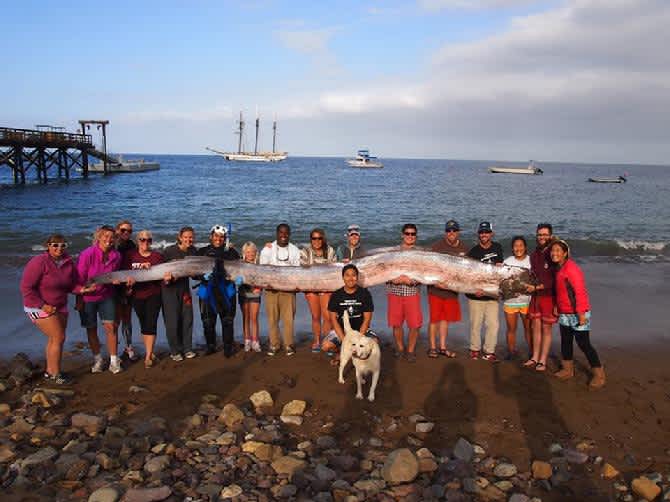Sea Monsters: Eighteen-foot Oarfish Body Discovered off California
OutdoorHub Reporters 10.16.13

Oarfish usually frequent depths of more than 3,000 feet under the ocean’s surface, but a marine science instructor found one off the coast of California’s Catalina Island on Sunday, October 13. Jasminie Santana, 26, first saw the dead oarfish 30 feet down in Toyon Bay, Fox News reported. Santana swam once around the creature to make sure it was dead, then decided to retrieve it as an educational specimen for her students at the Catalina Island Marine Institute (CIMI). The science teacher grabbed the fish by the tail and dragged it for 75 feet before coworkers from the CIMI ship Tole Mour waded in to help.
“About 15 more of the staff got down to lug it out and bring it on shore,” CIMI program director Jeff Chace told the New York Daily News. “I’ve been here for a little over 10 years, and I’ve not seen one at all.”
Very few have. Although the larger species of oarfish can grow to well over 36 feet long, few of these monsters ever reach the surface. Oarfish occasionally caught by anglers and commercial fishermen are usually no more than a few feet long. In 2003 British angler Val Fletcher caught an 11-foot, seven-inch oarfish on rod and reel by using squid as bait. Because they are rarely seen, neither Fletcher nor her companions at the time recognized the fish. As a marine science expert, Santana instantly knew what a rare find she had on her hands.
“It used to scare people,” Santana said. “It is believed that oarfish [are] what the [sea serpent] stories were based off because of its long tapered body.”

Only recently have researchers seen oarfish in their natural environment. Between the years of 2008 and 2011 scientists with the SERPENT project caught rare glimpses of a giant oarfish using a remote-controlled submersible. Giant oarfish are considered the longest bony fish and can weigh several hundred pounds.
The fish is now on display for CIMI’s students. Chace says the carcass may eventually be buried under sand so small animals can consume the flesh, leaving an intact skeleton behind. CIMI is an educational non-profit program that seeks to get students interested in marine science with hands-on experiences. To that end, CIMI offers a number of programs that teach students marine biology, sailing, and other water-related skills.
“On Catalina island right now we have public and private schools attending our programs,” CIMI’s Kent Woods told OutdoorHub. “We serve as many as 225 kids at one time on any of the three sites we have at Catalina.”

